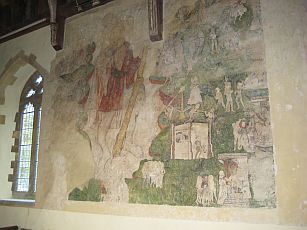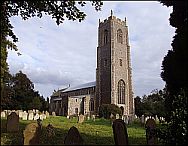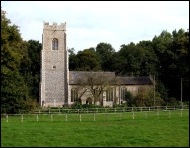In 1937, when many thicknesses of whitewash were removed from the walls of the nave, important medieval paintings were revealed. They were fully uncovered and treated under the skilled direction of Professor E W Tristram, of the Victoria and Albert Museum, and their full significance expounded.
The subject is the legend of St Christopher, than which there was no more popular subject for a wall-painting in medieval England. In more than 400 of our ancient parish churches a representation of the saint is still to be found, while the existence of many more examples which have now perished have from time to time been recorded.
In order properly to appreciate the painting at Hemblington a short summary of the legend is necessary.
Reprobus, which was Christopher’s original name, was a huge heathen giant whose one wish was to serve the strongest man in the world.
He entered the service of the King of Cana, but noticing one day that the king used the sign of the Cross to protect himself against the power of the devil, Reprobus forsook him and took service with the fiend.
But after a time, when he saw his new master making a long detour in order to avoid passing a wayside cross, and learning that the cross was the symbol of Christ, he realised that Christ must consequently be mightier than the devil, and once again transferred his service.
Consulting a holy hermit as to the best way he could use his immense strength in the service of Christ, he was advised that he could most effectively do this by undertaking to carry passengers safely across a certain very dangerous river.
Then comes the incident of the Christ-child, and the conversion and re-naming of the giant.
But there is a sequel to the legend and very skillfully the painter at Hemblington has seized upon it to render his picture complete.
In the centre is the great figure of the giant supported by his staff, and carrying the Christ-child on his right shoulder. He is wearing a red tunic with a green belt, and he has a chaplet of beads slung round his neck. He is represented as crossing a rushing stream which runs between two steep banks. The artist has conceived of this stream as the turning point of Christopher’s life, and on the two banks he has painted a series of scenes which show, on the one side the story of the saints’ life before, and on the other side his life after his conversion.
Unfortunately those shown on the left bank have for the most part disappeared, and only two remain.
The first, at the top, represents Reprobus, as he then was, in the service of the King of Cana, but of this scene all that now remains is part of a building and some figures.
Below this we see him seeking the devil as his master. On the left are two devils riding on horses, and before them stands Reprobus, to whom they are talking. The remaining episodes on this side have perished.
But on the right hand bank there are ten episodes, all of which are quite distinguishable.
According to the legend, as soon as the river had been crossed, Christ told Reprobus (now Christopher, for he had borne Christ on his shoulder) to plant his staff in the ground. He did so, and in the morning found that it had taken root and had flowered.
He then made his way to Lydia, and by means of the miracle of his staff made 8,000 converts to Christianity. This came to the ears of the heathen King Dagarus who ordered Christopher to sacrifice to the gods. This he refused to do, and the King threw him into prison.
It is at this point that the episodes on the right hand bank begin.
Starting from the bottom and working upwards, we have:
- Christopher, still holding his staff, being taken by a band of soldiers in armour to the King.
- Christopher before King Dagarus of Lydia. The saint appears on the left between two guards, one of whom carries a spear. Before him the crowned King is seated on a throne with a canopy.
- Christopher in prison with two women (Vysena and Aquyiyne) who were sent to tempt him. On the right, at the prison gate, is the jailor with his keys.
- Christopher is brought with Vysena and Aquyiyne, who were converted to Christianity, before the King sitting on his throne and holding a large sword.
- The martyrdom of Vysena and Aquyiyne. They are shown hanging by their hair on one arm of a gibbet, which is raised from earth by one man hanging on to the other arm, and two others pulling it down with a rope. (The painting is not in strict accord with the legend, in which Aquyiyne is said to have been hanged, and Vysena to have been beheaded, after an unsuccessful attempt had been made to burn her).
- The scourging of Christopher. He is seen tied to a tree with two ‘tormentors’ whipping him. This subject depicts one of the many tortures which were inflicted on him.
- Christopher again before the King. On this occasion he appears in a long tunic. The King seems to be threatening him.
- Christopher shot with arrows. Some of the arrows fall broken to the ground. On the right, King Dagarus (whose figure is indistinct) is struck by one of the arrows. According to the legend he was struck in the eye and blinded, whereupon the saint told him to anoint the eye with his blood, and on the morrow it would be healed.
- The beheading of Christopher. The saint lies decapitated on the ground, his head at his side. On the right stands a woman and on the left is the kneeling figure of the executioner.
- The conversion of Dagarus. The King is portrayed bearing scimitar and standing near a column or part of a building. Part of this subject may be missing, but there is no doubt that it depicts the converted King.
The above is a summary of the notes which Professor Tristram made in 1937.
He adds to his description: “There are but two other examples in this country in which these scenes are so represented, namely at St Keverne in Cornwall, where eight incidents are shown, four on each side, and at Shorwell in the Isle of Wight, where five scenes are depicted. The former paintings are somewhat indistinct and the subjects are difficult to decipher, but the latter are in a better state of preservation. The Hemblington paintings are also better preserved and have more incidents in the life of the saint, and can thus take priority as the important example of this particular scheme.”





